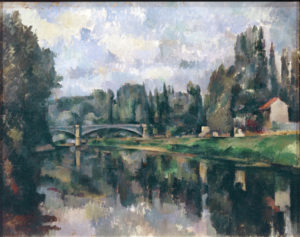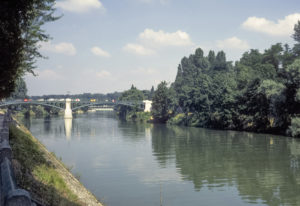R729 – Le Pont sur la Marne à Créteil, 1890-1894 (FWN288)
Pavel Machotka
(Cliquer sur les images pour les agrandir)
The site of Le Pont sur la Marne à Créteil, unlike the others, has remained highly visible. The painting’s style may be viewed as a gradual maturation of the first Chantilly style; the paint is thinner, the touches are lumped more loosely, and the effect (however careful the thought that had gone into it) is more relaxed and guileless. Because the touches are flat in the sky and moulded where they denote solids, they remain close to the surfaces they represent.
As in Cézanne’s paintings of receding roads, where the roads curve before pushing too deeply into space, the river here recedes only as far as the bridge, which lies exactly parallel to the canvas and constitutes the final plane. Perhaps the best comparison is with the edge of the pool in Bassin et lavoir du Jas de Bouffan, which interrupts the chestnut avenue; there, the pool acts as a constraint, while here the final plane is the subject itself. It spans exactly half the canvas (stopping as it does in the middle), but the plane that it establishes extends subtly all the way to the right. Two very small structures, set the same distance apart as the bridge piers, prolong it.
A sense of understated but satisfying graveness is present in the painting, and it is perhaps these artful constructions that help explain it: a measured depth, a rhythmic surface, a subtle, delicately hidden focal point in the very center. They are devices that do no more, and no less, than accept the just perceivable order of nature and offer us a more lucid view of it.
Source: Machotka, Cézanne: Landscape into Art.



